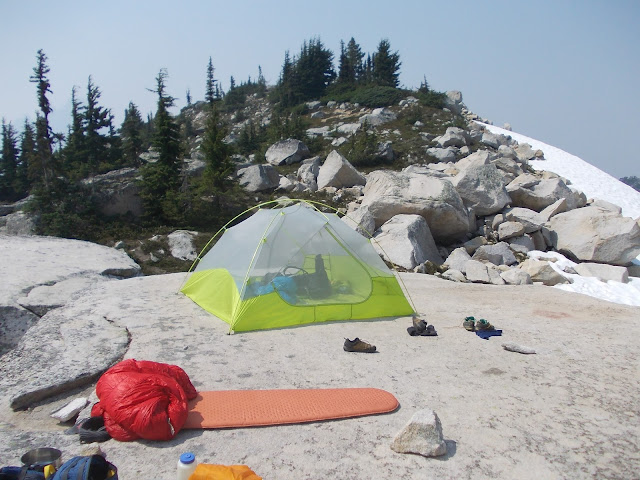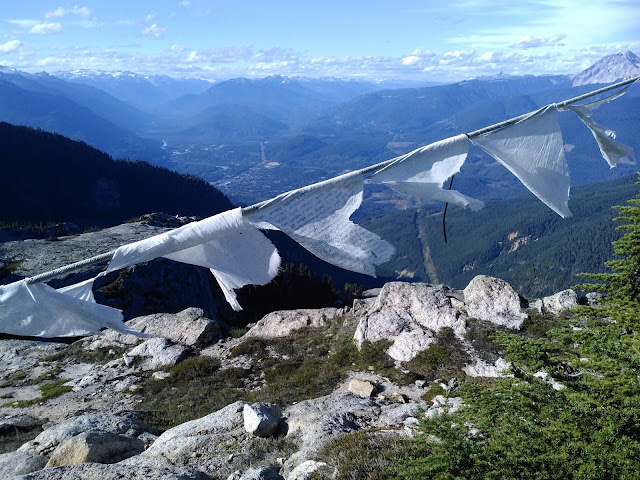Summer 2017 has been primarily about alpine climbing on our local mountains. Several reasons. One is that Leo's interests have moved in that direction, so it seemed like a good idea to try to pass on my (limited!) knowledge. Long spells of very settled weather, often too hot for serious rock climbing, have also been an encouragement. Finally, my two nephews, Jeremy and Ollie, came out from Britain for one week in July, and demanded to be exercised. This resulted in some hikes that were good research for more ambitious trips after they had left.
Summit #1 was
Niobe in the Tantalus, which I have wanted to climb since looking across at it from
Alpha in summer 2016. Leo was easily persuaded by the required helicopter flight (his first) and my agreement that he could take the splitboard, as there still seemed be plenty of snow left from the unusually prolonged 2016/17 winter. Good snow cover also held out the possibility of ascending the oddly named "
Niobe without Pelops" route, which follows an aesthetic snow couloir below the col between those two mountains. The standard route later in the season is a more roundabout trudge over the very minor Iota then Pelops to reach the same col. The trip went very well. Leo used crampons and ice axe for the first time and notched up splitboard descents from halfway up the ascent route on two consecutive days. Perhaps the most challenging aspect of the trip was the overnight camp. Our intended site, the sandspit beach on Lake Lovely Water, was buried by about 50-100cm of snow, so we had to construct a flat snow platform and pitch the tent on that. On the positive side, we had that fantastic location entirely to ourselves.
 |
| Niobe from across the valley on a hazy day; approx line of "Niobe without Pelops" shown |
 |
| Snow camp halfway through construction |
 |
| Sunset over Lake Lovely Water |
 |
| Snow campfire |
 |
| Dawn over Lake LW |
 |
| Ascent couloir, col between Niobe and Pelops above |
 |
| Lake LW from Niobe summit, still partially ice covered |
 |
| Alpha from Niobe summit (Cloudburst visible over the ridge centre-right) |
 |
| View north-west from Niobe summit. Black Tusk, Wedge and Garibaldi all visible on the skyline. Omega centre-right. |
 |
| Strapping in to ride down |
 |
| Post-swim cup of tea |
During Jeremy and Ollie's visit we hiked in to Black Tusk via an overnight at the Taylor Meadows campground. James and Leo (and briefly Ollie) rode snowboards most of the way down from just below the summit.
A few days later Ollie, Jeremy and I visited Wedgemount Lake, another spectacular location in Garibaldi provincial park. At Wedgemount I saw the north side of Wedge, the park's highest peak, for the first time. It was also still retaining early season snow cover late into July. Leo and I had been contemplating trying Mt Garibaldi, but read that the bergschrund on the standard route had become impassable. I suggested Wedge as an alternative, pointing out that it is actually higher than Garibaldi; in fact, it is the highest mountain in the provincial park. Two weeks later we headed up to do it. The weather was slightly unstable and quite warm but having studied SpotWx carefully we identified a very specific window for 24 hours in which clouds would clear just before evening, night time temperatures hopefully cool enough to re-freeze the snow on the route and clouds stay away until lunchtime the next day, by when we hoped to have already summited. Remarkably this is exactly what happened.
The
North Arete of Wedge is described as a Coast Mountains classic in the Alpine Select guidebook and elsewhere. As far as I could tell it was a step up from Niobe, being longer, steeper and having much more glacier travel, but oddly I couldn't find anyone who had actually done it. One friend had climbed a harder parallel route nearby many years ago and suggested we might need twin ice tools for the steep part - we did so, but they weren't necessary. The earlier parts of the route are quite mellow snow-plodding, finishing up on an easy but exposed ridge. Beyond this there is a short section (100-150m?) of climbing on the mountain's actual north face, kicking steps up 40-50 degree snow while weaving between loose rock outcrops. Later in the season I guess there might be both more rock and some bare ice, making it more demanding. We kept a rope on throughout this section and "pitched it out" with ice axe and
snow fluke anchors. Then we reversed the same process in descent.
The most unexpected moment of the day was seeing a very fast-moving solo climber coming up behind us. He arrived on the summit about five minutes after us. It was Jim Sandford, Squamish 1980s/ 1990s sport climbing legend, who has taken up alpine speed ascents in his late 50s. He had left the valley trailhead that morning at about the same time as we had left our tent, 1200m vertically below us! Jim gave us our best quote of the summer. Just before heading down he spied Leo's
Phantom 4 by the summit cairn and exclaimed "that's a f***ing drone!". He then insisted that Leo film him as he descended the arete but by the time Leo had the machine ready he was an almost invisible dot far below.
 |
| A very foreshortened Wedge seen from the toe of the glacier - red line shows ascent route |
 |
| Upper part of the route |
 |
| Our camp, by a small lake below the glacier |
 |
| Leo by our camp |
 |
| Leo looking out over Wedgemount lake from our camp - with cup of Yorkshire (actual?) Gold tea |
 |
| High on the glacier next morning |
 |
| Leo leading steep snow up to the start of the proper ridge |
 |
| Leo on the summit, looking east |
 |
| Local legend Jim S on the summit looking north (from his FB page but arguably my © as I pressed the shutter) |
 |
| Leo descending just below the summit |
Leo became quite buried in academic work and preparation for a piano exam after Wedge. Smoke from wildfires in the BC interior also made alpine trips unappealing. However early in August my friend Chris H convinced me to venture south to the Chilliwack Lake area, which I had not visited before. The peaks there are part of the North Cascades range straddling the Canada-US border. The specific objective was the Nesakwatch spires, enticingly described as a
mini-Bugaboos by some people. The hike up there with camping gear and a full rock climbing rack was somewhat brutal but fortunately my legs were still in good condition from the trips in July. On the first day we climbed the easy
West Ridge of Rexford. Mostly scrambling except for a couple of roped pitches at the top. On the second day we attempted
Dairyland, a five pitch route on the steep South Nesakwatch spire. Though we succeeded on the route, it was a tough day. We had route-finding issues low down then Chris succumbed to some mystery sickness on the last splitter crack pitch, abandoning the lead then vomiting at the belay while I led it! (Heat exhaustion perhaps? The air was also very smoky, making it slightly hard to breathe at times.) I made a final wrong decision on that pitch, leaving the crack prematurely to exit up a burly overhanging chimney.
 |
| Excellent camp spot on "the" giant flat boulder (the guidebook mentions one but there are several) |
 |
| North and South Nesakwatch spires and Mt Rexford from the camp - ascent lines shown in red |
 |
| Chris showing good back-and-foot form on the final chimney on Rexford |
 |
| Chris getting ready to rappel from Rexford; Nesakwatch spires behind |
 |
| South Nesakwatch from Rexford west ridge - my last photo before dropping my camera (how I got it back is a long story ...) |
In the last week in August Leo got his workload under control and the smoke cleared. He and his friend Nic did an ambitious day trip to
Cloudburst, a complex mountain just north of Squamish (but visible from our house). Their main objective was to check out the forest road access to the mountain with the winter season in mind, but they ended up reaching to the summit. I was impressed. They brought back some scary stories of soloing mossy 5.6 and ice axe arrests on steep snow; I am nervously filing all that under "learning curve".
A few days after that, Leo and I also climbed Habrich, the pointy rock peak visible from many points in Squamish - notably Leo's school. Also the star feature of
this photo collection. It was my third time up there but of particular interest to me this year. In May I played a leading role in
discouraging a large-scale project to build a via ferrata on the mountain. We climbed the Escape Velocity route which links short sections of clean rock with heather ledges. Not the most dramatic alpine rock route but easy to follow and entertaining in places. Leo led the nice final pitch which ends abruptly on the summit. He had led some trad pitches before but this was his first pure onsight without knowledge of the placements. It seemed to go OK. We spent a little time on the summit gazing over at the Sky Pilot bowls, trying to figure out our route when we took snowboards there during a low-visibility day in May. Rappelling down went fairly uneventfully aside from some rope twisting and ledge piles which Leo got his share of managing. It was his first multi-pitch rappel experience. I made a mental note to teach him about
prusik backups before we did it again - bad dad.
As we had plenty of time to catch the last gondola and conditions were amazingly warm and stable we explored the ridge system west of Habrich for an hour or so before heading down. Leo flew his drone and I stumbled over prayer flags hung in a hidden spot overlooking Squamish. (A memorial to
this guy, I believe.)
 |
| Habrich from Sky Pilot showing the approach trail. The Escape Velocity route is just out of view on the west ridge |
 |
| Leo finishing the second pitch of Escape Velocity |
 |
| Leo leading the last pitch of Escape Velocity |
 |
| Habrich summit looking north |
 |
| Prayer flags hidden on the lower west ridge of Habrich. Cloudburst just left of centre skyline, Garibaldi up to the right |
Some time in early August the fifth anniversary of our move to Squamish passed. No official family celebration but I paused for reflection on that date. Obviously I am happy with the decision to come here. I feel very far from exhausting the potential of this place. Options keep expanding and the to-do list only grows longer. Aside from the Chilliwack trip, all the locations mentioned in this blog post were accessed from trailheads within an hour's drive of home!
































